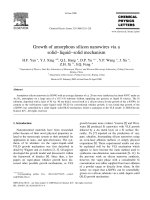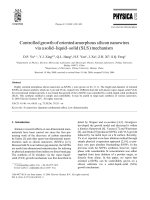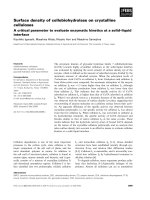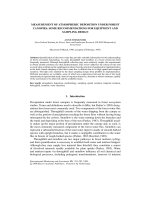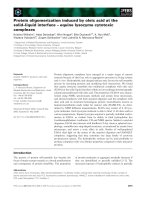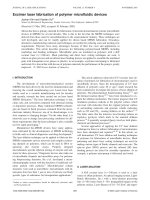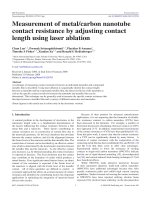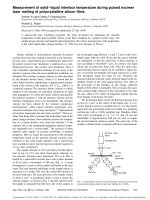measurement of solid liquid interface temperature during pulsed excimer laser melting of polycrystalline silicon films
Bạn đang xem bản rút gọn của tài liệu. Xem và tải ngay bản đầy đủ của tài liệu tại đây (90.12 KB, 3 trang )
Measurement of solid–liquid interface temperature during pulsed excimer
laser melting of polycrystalline silicon films
Xianfan Xu and Costas P. Grigoropoulos
Department of Mechanical Engineering, University of California, Berkeley, California 94720
Richard E. Russo
Energy and Environmental Division, Lawrence Berkeley Laboratory, Berkeley, California 94720
͑Received 13 May 1994; accepted for publication 27 July 1994͒
A nanosecond time resolution pyrometer has been developed for measuring the transient
temperature of thin polycrystalline silicon ͑p-Si͒ films irradiated by a pulsed excimer laser. The
sample design structure and material optical properties allow direct measurement of the temperature
at the solid–liquid phase change interface. © 1994 American Institute of Physics.
Surface melting of semiconductor materials by pulsed
excimer lasers has been studied extensively in the literature.
In most cases, rapid melting and resolidification induced by
the pulsed excimer laser irradiation is understood as a one-
dimensional process. The excimer laser irradiation offers a
well controlled experimental technique for the study of the
interface response when the local equilibrium conditions are
disturbed. The interface response function is often described
by the interface kinetic theory
1
where it is shown that the
solid–liquid interface superheating is approximately propor-
tional to the velocity of the interface: ⌬TϭCV
int
, where C is
a material constant. This interface kinetic relation is widely
adopted in the literature for numerical simulation of rapid
melt propagation. To verify the kinetic relation and quantify
the material constant C, both the interface velocity and the
interface temperature need to be determined. The interface
velocity has been studied by the transient conductance
measurements,
2
while various transient temperature mea-
surement techniques have been developed.
3–5
Measurement
of interface temperature has also been reported.
6,7
However,
rather than being able to measure the temperature right at the
phase change interface, these methods measure the tempera-
ture at a certain distance away from the interface,
6
or the
response due to the temperature-dependent material proper-
ties integrated over a certain depth.
7
The accuracy of these
methods relies largely on accurate knowledge of material
properties. Here we report the measurement of the interface
temperature based on the transient thermal emission mea-
surement at the solid–liquid interface with a nanosecond
time resolution ͑notice that the fastest pyrometer reported is
of 2
s time resolution
8
͒.
The sample structure is a 0.5
m thick p-Si film depos-
ited on top of a 0.5 mm thick fused-quartz substrate, by
low-pressure chemical-vapor deposition. The p-Si film is
heated by a pulsed KrF excimer laser with a pulse duration
of 26 ns and a wavelength of 248 nm ͑Fig. 1͒. A beam
homogenizer is used to ensure spatial uniformity in the laser
beam. The laser intensity uniformity on the sample surface is
measured to be within 10% over the central 90% portion of
the laser beam spot. The laser spot size on the sample surface
is about 6 mm
2
. A germanium diode is used to detect the
emission signals. As shown in Fig. 1, thermal emission from
the sample is measured from the back side of the sample, in
the wavelength range between 1.1 and 1.7
m. In this wave-
length range, both the solid silicon and the quartz substrate
are transparent, so that the emissivity of these materials is
zero according to Kirchhoff’s Law. In contrast, the liquid
silicon has an emissivity about 0.28. Thus the entire mea-
sured thermal emission signal can be ascribed to liquid sili-
con. At near-IR wavelengths, the liquid silicon has a radia-
tion absorption depth less than 18 nm. Therefore the
measured thermal emission comes from the liquid in the im-
mediate vicinity of the solid–liquid interface. The effect of
the movement of the interface on the energy collection
͑depth of field effect͒ is negligible. This is because the maxi-
mum melting depth achieved in this experiment is less than
0.4
m, which is five orders of magnitude smaller than the
focal lengths of the lenses ͑65 mm͒.
The germanium diode senses the thermal emission from
an area of 1 mm
2
at the center of the heated spot. It is re-
versely biased to achieve a rise/fall time of 1 ns. The electric
signal from the germanium diode is recorded on a digitizing
oscilloscope with a 1 GHz sampling rate. Bandpass filters
with center wavelengths at 1.2, 1.4, 1.5, and 1.6
m and
bandwidths of approximately 0.08
m are used to acquire
the spectral thermal emission signals. The emissivity of the
sample is obtained from a transient reflectivity measurement.
FIG. 1. Experimental setup for transient thermal emission and emissivity
measurements during pulsed excimer laser melting of p-Si films.
1745Appl. Phys. Lett. 65 (14), 3 October 1994 0003-6951/94/65(14)/1745/3/$6.00 © 1994 American Institute of Physics
Downloaded¬13¬Dec¬2007¬to¬128.46.193.173.¬Redistribution¬subject¬to¬AIP¬license¬or¬copyright;¬see¬ />A quartz halogen ͑QH͒ lamp is used as the light source. The
light of the QH lamp ͑Fig. 1͒ is focused onto the sample
surface with a beam spot size of about 1 mm
2
. The reflectiv-
ity of this beam is refocused by lenses onto the germanium
diode and recorded by the oscilloscope. Bandpass filters ͑the
same as those used in emission measurement͒ are used to
measure the reflectivity at different wavelengths. Two mea-
surements are taken at each wavelength and laser fluence,
one for the thermal emission measurement ͑with the QH
lamp off͒ and one for the reflectivity measurement which
also includes the emission signal. The reflectivity is obtained
by subtracting the thermal emission signal from the total
signal. To eliminate the effect of the laser energy instability,
the fluence of each laser shot is measured. The experimental
data are accepted when the measured laser fluence has the
desired value. To eliminate the effect of the laser energy
instability. The surface of the sample shows little change
from shot to shot for the range of laser fluences used in this
experiment.
Planck’s distribution of blackbody radiation intensity
law is used to derive the temperature from the measured
thermal emissions:
e
b
ϭ
2
C
1
5
exp
͑
C
2
/T
͒
Ϫ 1
, ͑1͒
where e
b
is the blackbody emissive power, and C
1
and C
2
are blackbody radiation constants. The detector collects ther-
mal emission within a solid angle ͑
1
to
2
,
1
to
2
͒ and a
wavelength bandwidth ͑
1
to
2
͒. The voltage signal re-
corded on the oscilloscope, V, is expressed as
VϭW/
͵
1
2
͵
1
2
͵
1
2
⑀
Ј
͑
,
,
,T
͒
͑
͒
D
͑
͒
ϫ e
b
d
d
d dA. ͑2͒
In the above equation, W is the impedance of the oscil-
loscope ͑50 ⍀͒,
͑͒ the spectral transmission of the lenses
and filters, D() the responsivity of the germanium diode ͑in
units of A/W͒,
⑀
Ј
͑,
,
,T͒ the directional spectral emissivity,
and dA the area on the sample where the thermal emission is
sensed. Invoking Kirchhoff’s law, the directional spectral
emissivity is equal to the directional spectral absorptivity:
⑀
Ј
͑
,
,
,T
͒
ϭ
␣
Ј
͑
,
,
,T
͒
. ͑3͒
For an opaque material ͑such as liquid silicon͒, the spec-
tral directional absorptivity can be expressed as
␣
Ј
͑
,
,
,T
͒
ϭ 1ϪR
s
͑
,Ϫ
,
,T
͒
Ϫ R
d
. ͑4͒
R
s
͑,Ϫ
,
,T͒ is the specular reflectivity while R
d
is the
diffuse reflectivity. It is assumed that the melt propagation
front is planar, and the diffuse reflectivity at the melt front
can be neglected. Thus the emissivity can be obtained from
the specular reflectivity measurement:
⑀
Ј
͑
,
,
,T
͒
ϭ 1ϪR
s
͑
,Ϫ
,
,T
͒
. ͑5͒
The temperature is obtained by solving Eq. ͑2͒ from the
thermal emissions measured at four different wavelengths.
The temperature measurement is calibrated at steady state
with a quartz halogen lamp, whose temperature is measured
by a NIST calibrated pyrometer. The confidence level in de-
termining the absolute temperature value is estimated to be
Ϯ50 K. The error in determining the relative temperature
͑temperature difference at different time or at different flu-
ence͒, which is determined by the resolution of the digitizing
oscilloscope, is Ϯ15 K.
Figure 2 shows thermal emission signals at the wave-
length of 1.5
m. The thermal emission measurement also
yields the melting duration ͑indicated by arrows͒, since only
liquid silicon emits light in the wavelength range between
1.1 and 1.7
m. Comparing the thermal emission signal at
Fϭ0.55 and 0.65 J/cm
2
, it can be seen that the maximum
interface temperature increases with the laser fluence. How-
ever, when the laser fluence is higher than 0.65 J/cm
2
, the
maximum interface temperature does not increase with the
laser fluence. The effect of a temperature gradient at the
solid–liquid interface is considered in calculating the inter-
face temperature. From numerical simulation,
9
it is found
that the temperature gradient at the interface ͑about 3.3 K/nm
at a laser fluence of 0.95 J/cm
2
͒ causes the measured tem-
perature to be approximately 40 K higher than the actual
interface temperature. The maximum solid–liquid interface
temperatures at different laser fluences are shown in Fig.
3͑a͒.
In our previous work,
9
the transient melting front posi-
tion was measured using the transient conductance method.
The transient melting depth was calculated using a heat con-
duction model which incorporates a melting front tracking
algorithm and the interface response function. The optical
refractive index of the p-Si film at the excimer laser wave-
length was measured using a variable angle spectral ellip-
someter, which is n
˜
exc
ϭ1.2ϩ2.8i. Thermal and optical prop-
erties of bulk silicon
10,11
and quartz
10
were used in the
calculation. The measurement matched well with the numeri-
cal simulation for quantities such as melt depth and melt
FIG. 2. Transient thermal emission signal at ϭ1.5
m. ͑a͒ Fϭ0.55 J/cm
2
,
͑b͒ Fϭ0.65 J/cm
2
, ͑c͒ Fϭ0.75 J/cm
2
, and ͑d͒ Fϭ0.95 J/cm
2
.
1746 Appl. Phys. Lett., Vol. 65, No. 14, 3 October 1994 Xu, Grigoropoulos, and Russo
Downloaded¬13¬Dec¬2007¬to¬128.46.193.173.¬Redistribution¬subject¬to¬AIP¬license¬or¬copyright;¬see¬ />duration. Here we compare the melt duration obtained from
the thermal emission measurement with numerical simula-
tions ͓Fig. 3͑b͔͒. Good agreement has been achieved be-
tween the measured melt duration and the calculations. The
possibility that the high-temperature solid silicon can con-
tribute to the thermal emission measured from the back side
of the sample is examined by measuring the surface reflec-
tance. The surface reflectivity measurement also yields the
melting duration due to a large reflectance increase of silicon
upon melting. The melting durations measured by surface
reflectance are in close agreement with those obtained from
thermal emission measurement. Considering that any pos-
sible thermal emission from the high-temperature solid sili-
con can last much longer than the melting duration, we can
dismiss the possibility that thermal radiation is emitted from
high-temperature solid silicon.
The calculated maximum melt front velocities at differ-
ent laser fluences are shown in Fig. 3͑c͒. A comparison be-
tween the interface velocity and the interface temperature
͓Figs. 3͑a͒ and 3͑c͔͒ allows us to determine the coefficient C
in the interface response function. Assuming that there is a
linear relation between the interface superheating tempera-
ture and the interface velocity at fluences lower than 0.65
J/cm
2
, the response function coefficient C is determined to
be around 6 K/͑m/s͒. When the laser fluence is higher than
0.65 J/cm
2
, the interface superheating temperature is ‘‘satu-
rated’’ at about 110 K. In some cases, the maximum melt
depth is used instead of incident energy as an indication of
the actual energy coupled to the material. Calculation of
maximum melt depth versus laser fluence is presented in Fig.
3͑d͒.
Thermal emission from the top of the sample is also
measured to verify that the surface temperature does not
reach the boiling temperature ͑2628 K͒. In the case of sur-
face evaporation, the solid–liquid interface velocity in-
creases only slightly with fluence; the excess laser energy is
consumed by the latent heat of vaporization. The experimen-
tal results show that the maximum surface temperature at the
laser fluence of 0.95 J/cm
2
is about 2100 K, well below the
boiling temperature of liquid silicon.
Support of this work by the National Science Founda-
tion, under Grant No. CTS-9210333, is gratefully acknowl-
edged. R. Russo acknowledges the support by the U.S. De-
partment of Energy, Office of Basic Energy Sciences,
Division of Chemical Sciences, under Contract No. DE-
AC03-76SF00098. The authors also want to acknowledge
the help of Andrew C. Tam of IBM Almaden Research Cen-
ter and Hee K. Park during the experimental work, and
Xiang Zhang for sample preparation.
1
K. A. Jackson, in Crystal Growth and Characterization, edited by R. Ueda
and J. B. Mullin ͑North-Holland, Amsterdam, 1975͒,p.21.
2
M. O. Thompson and G. L. Galvin, Proceedings of the Materials Research
Society, edited by J. Narayan, W. L. Brown, and R. A. Lemons ͑North-
Holland, New York, 1985͒, Vol. 13, p. 57.
3
N. Fabricius, P. Hermes, D. Von der Linde, A. Pospieszczyk, and B. Stritz-
ker, Solid State Commun. 58, 239 ͑1986͒.
4
P. Baeri, S. U. Campisano, E. Rimini, and J. P. Zhang, Appl. Phys. Lett.
45, 398 ͑1984͒.
5
G. E. Jellison, Jr., D. H. Lowndes, D. N. Mashburn, and R. F. Wood, Phys.
Rev. B 34, 2407 ͑1986͒.
6
J. A. Kittl, R. Reitano, M. J. Aziz, D. P. Brunco, and M. O. Thompson, J.
Appl. Phys. 73, 3725 ͑1993͒.
7
B. C. Larson, J. Z. Tischler, and D. M. Mills, J. Mater. Res. 1, 144 ͑1986͒.
8
G. M. Foley, M. S. Morse, and A. Cezairliyan, in Temperature, Its Mea-
surement and Control in Science and Industry, edited by J. F. Schooley
͑American Institute of Physics, New York, 1982͒, Vol. 5, p. 447.
9
X. Xu, C. P. Grigoropoulos, and R. E. Russo, J. Heat Transfer ͑in press͒.
10
Y. S. Touloukian, Thermophysical Properties of Matter, Thermal Conduc-
tivity ͑IFI/Plenum, New York, 1970͒.
11
K. M. Shvarev, B. A. Baum, and P. V. Gel’d., Sov. Phys. Solid State, 16,
2111 ͑1975͒.
FIG. 3. ͑a͒ measured maximum interface temperature. ͑b͒ Comparison be-
tween the measured and calculated melting duration. ͑c͒ Calculated maxi-
mum melting velocity and ͑d͒ calculated maximum melting depth at differ-
ent laser fluences.
1747Appl. Phys. Lett., Vol. 65, No. 14, 3 October 1994 Xu, Grigoropoulos, and Russo
Downloaded¬13¬Dec¬2007¬to¬128.46.193.173.¬Redistribution¬subject¬to¬AIP¬license¬or¬copyright;¬see¬ />
